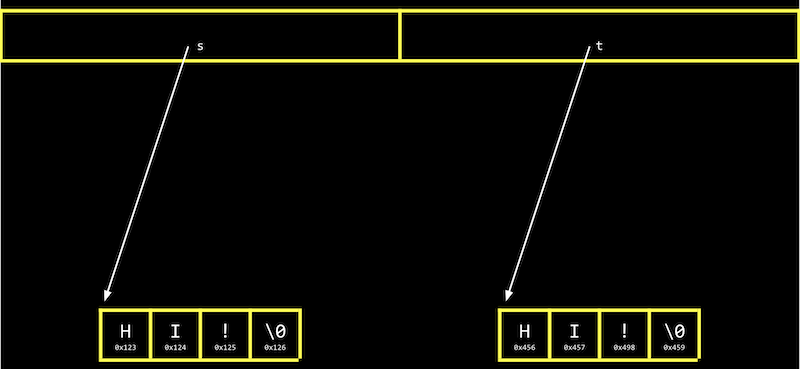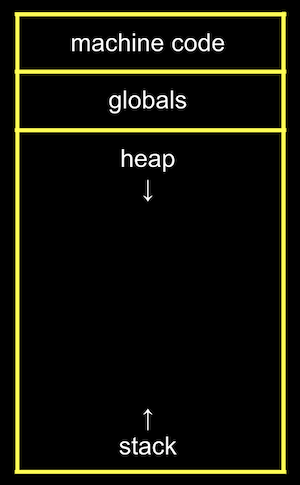Lec 04: Memory
1. Hexadecimal
1.1. What is it
In week2 (Arrays), we knew that each byte has an address, or identifier, so that we can refer to where our data is actually stored.
It turns out that, by convention, the addresses for memory use the counting system hexadecimal, or base-16, where there are 16 digit: 0~9, and A~F represent 10~15.
In this example, 0x0F is 15 in decimal, where 0x is the prefix for hexadecimal.
1.2. Why use it
One digit in hexadecimal is equal to four digits in binary, which binary is the counting system used by computers. (Each digit in hex with 16 different values, which map to four bits in bin, i.e. 2^4 = 16)
Consequently, we could conveniently represent a byte in binary by using two digit in hex.
1.3. Application
Due to each byte has an address, we'll use hexadecimal for each address or location for computer's memory.
Also the RGB color system conventionally uses hexadecimal to describe the amount of color, i.e. 0xRRGGBB.
E.g., 0x00 00 00 in hex represents 0 for each of red, green and blue, for a combined color of black. And 0xFF 00 00 would be 255 for red, which is the highest possible of amount of red. Similarly, 0xFF FF FF is the highest value of each color, combined to the brightest color white.
2. Addresses and Pointers
2.1. What are they
We know that different variable may have a different type, e.g. int, double etc. Besides, the variables are stored somewhere in the computer's memory, just like the picture below.
The address where stored this variable might look 0x12345678, and the type of address value is called the pointer, we can save the address of this variable in a pointer variable p, which we can think of as a value that "points" to a location in memory.

To declare a pointer, we can use * (also refer to dereference operator).
This perhaps be confusing, *p is the dereferenced value of p, but we assign a value to it.
This is similar to the initialization of an array, where [50] is not get the 50th variable, but to declare the length of this array.
Therefore, int *p is mean that the type of *p is an int, where *p is the dereferenced value which is an int, thus p is a pointer to the type int. When we initialize it, we assign value to p instead of *p.
2.2. & and dereference operator *
In C, we can actually see the address with the & operator, which means get the address of this variable. We already know that it is the pointer which the type of address, to print out through printf we use %p for the format code for an address.
Correspondingly, the * operator, aka dereference operator, is to go to the location that this pointer points to.
2.3. the size of pointers
It turns out that int have four bytes in computer's memory. Modern computer systems are “64-bit”, meaning that they use 64 bits to address memory, so a pointer will in reality be 8 bytes, twice as big as an integer of 4 bytes.
3. Application of the pointer
3.1. Strings
In fact, the CS50 library defines a type that doesn't exist in C, string, as char *, with typedef char *string. It turns out that string s is just a pointer, the first address to s.
Due to the string in C is ended by \0 aka nul, we can easily find out where the end of this string.
3.2. Strings comparison and copying
Once we know that what string or char * stored is the address of first character in each string, we'll understand that it's wrong to compare two strings through compare their pointers.

Similarly, if we want to copy a string to another, we cannot just simply assign one string(pointer) to another one (pointer), cause this would make two pointers to the same location instead of copying.
To actually make a copy of a string, we have to do a little more work, and copy each character in original string (s) to somewhere else in memory.
We create a new variable, t, of the type of char *, with char *t. Now we wanna point it to a new chunk of memory that's large enough to store the copy of the string. With malloc (memory allocate, in stdlib), we allocate some number of bytes in memory (that aren't already used to store other memory), and we pass in the number of bytes we'd like to mark for use.
3.3. Error checking
We can add some error-checking to our program:
If our computer is out of memory, malloc will return NULL, the null ptr, or a special value that indicate there isn't an address to point to. So we should check for that case, and exit if t is NULL.
We could also check that t has a length, before trying to do something in that memory.
Finally, we should free the memory we allocated earlier, which marks it as usable again by some other program. We call the free function and pass in the pointer t, since we're done with that chunk of memory, we no longer need that chunk of memory.
We can actually also use the strcpy function, from the C’s string library, with strcpy(t, s); instead of our loop, to copy the string s into t.
3.4. scanf
We can get a string using scanf.
But we haven't actually allocate any memory for s, so we need to call malloc to allocate some memory to s, or char s[N].
Now, if the user types in a string of length 3 or less, our program will work safely. But if the user types in a longer string, scanf might be trying to write past the end of our array into unknown memory, causing our program to crash.
3.5. Pointer arithmetic
Pointer arithmetic is mathematical operations on addresses with pointers.
*s goes to the address stored in s, and *(s+1) goes to the location in memory that the next of the array instead of the next bit, this is to say, add the bits of the type have to this address.
We can even try to go to the address in memory that we shouldn't, like with *(s + 1000000000), and when we run our program, we’ll get a segmentation fault, or crash as a result of our program touching memory in a segment it shouldn’t have.
4. Memory leaks and Garbage values
4.1. Memory leaks and Valgrind
valgrind is a command-line tool that we can use to run our program and see if it has any memory leaks, or memory we've allocated without freeing, which might eventually cause out computer to run out of memory.
4.2. Garbage values
With *y = 13, we trying to put the value 13 at the address y points to. But since we never assigned y a value, it has a garbage value, or whatever unknown value that was in memory, from whatever program was running in our computer before.
So when we're trying to go to the garbage value in y as an address, we're going to some unknown address, which is likely to cause a segmentation fault, or segfault.
5. Memory layout
5.1. What is memory layout
Within our computer's memory, the different types of data that need to be stored for our program are organized into different sections.

- The machine code section is our complied program's binary code. When we run our program, that code is loaded into the "top" of memory.
- Just below, or in the next part of memory, are global variables we declared in our program.
- The heap section is an empty area from where
malloccan get free memory for our program to use. - As we call
malloc, we starting allocate memory from the top down. - The stack section is used by functions in our program as they called, and grows upward.
- E.g. the picture below.

5.2. heap/stack/buffer overflow
If we called malloc for too much memory then the heap section run out of space, we'll have a heap overflow, since we end up going past our heap.
Or, if we call too much functions without returning from them, we'll have a stack overflow, where our stack has too much memory allocated as well.
A buffer overflow occurs when we go past the end of a buffer, some chunk of memory we’ve allocated like an array, and access memory we shouldn’t be.
6. File I/O
6.1. fopen, fprintf and FILE type
With the ability to use pointers, we can also open files, like a digital phone book.
fopen is a new function that we can use to open a file, which will return a pointer to a new type, FILE, that we can read from and write to.
-
The first argument of
fopenin this example is the name of file, and the second is the mode we want to open file in, i.e.rfor read,wfor write,afor append or adding to. -
Similarly as above, we have to add a check to exit if we couldn't open the file for some reason.
After we get some strings, we could use fprintf to print to a file.
Finally, we close the file with fclose.
Now we can create our own CSV files, a file of comma-separated values (like a mini-spreadsheet), programmatically.
6.2. Graphic
We can read in binary and map them to pixels and colors, to display images and videos. With a finite number of bits in an image file, though, we can only zoom in so far before we start seeing individual pixels.
- With artificial intelligence and machine learning, however, we can use algorithms that can generate additional details that weren’t there before, by guessing based on other data.
Let’s look at a program that opens a file and tells us if it’s a JPEG file, an image file in a particular format:
- First, we define a
BYTEas 8 bits, so we can refer to a byte as a type more easily in C. - Then, we try to open a file (checking that we indeed get a non-NULL file back), and read the first three bytes from the file with
fread, into a buffer calledbytes. - We can compare the first three bytes (in hexadecimal) to the three bytes required to begin a JPEG file. If they’re the same, then our file is likely to be a JPEG file (though, other types of files may still begin with those bytes). But if they’re not the same, we know it’s definitely not a JPEG file.
We can even copy files ourselves, one byte at a time now:
- We use
argvto get arguments, using them as filenames to open files to read from and one to write to. - Then, we read one byte from the
sourcefile into a buffer, and write that byte to thedestinationfile. We can use awhileloop to callfread, which will stop once there are no more bytes to read.